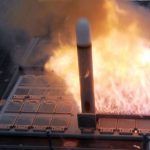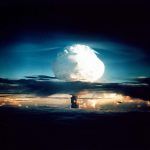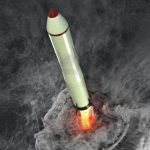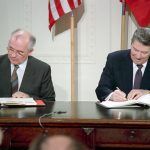Arms control on the brink
By Kingston Reif | November 1, 2018

Let’s get a few things out of the way up front. Since the Obama administration formally determined Russia to be in violation of the 1987 Intermediate-Range Nuclear Forces (INF) Treaty in 2014, Moscow has dissembled in the face of the charges and shown next to no willingness to address US concerns. Russia’s production, testing, and deployment of an illegal ground-launched cruise missile with a range between 500 to 5,500 kilometers is unacceptable and merits a strong response from all nations that value arms control and the reduction of nuclear risks. The Obama administration did not impose sufficient costs on Russia for its violation, and its diplomatic efforts to bring Russia back into compliance were limited and unsuccessful. And European leaders have been far too timid in condemning Russia’s cheating.
But this doesn’t mean that President Donald Trump’s announcement on October 20 that he plans to “terminate” the pact is a smart or effective answer to a difficult problem. Quite the opposite in fact. Trump’s move is an unnecessary and self-defeating own-goal (to use the soccer term) that together with the uncertain future of the 2010 New Strategic Arms Reduction Treaty (New START) has brought the bilateral US-Russia arms control framework to the brink of collapse.
The consequences of withdrawal. The US response to Russia’s breach of the treaty should be guided by several principles. These include: preventing Russia from gaining a military advantage; ensuring that Russia shoulders the blame if the treaty collapses; keeping allies united; and exhausting all diplomatic and treaty-compliant military options to resolve the compliance dispute between the two side before leaving the treaty.
Trump’s withdrawal plan fails all of these tests.
Without the treaty, Russia’s currently illegal missiles would become legal, and there would be no constraints on their production and fielding. This would increase the threat to our allies and deployed forces in range of the missiles and exacerbate military, and perhaps nuclear, tensions in Europe at time when the bilateral relationship is already deeply strained.
In addition, withdrawal lets Russia off the hook for its violation and leaves the United States holding the bag for the treaty’s demise. In the wake of Trump’s announcement, Moscow, which denies that it is violating the treaty and has instead accused Washington of cheating, is already positioning itself to be viewed as the responsible party trying to save the US-Russia arms control architecture in the face of US efforts to destroy it.
Terminating the treaty has also created another source of division with allies in Europe already unsettled by Trump’s withdrawal from several other international agreements, including the 2015 Iran nuclear deal. The European Union declared in a statement that the United States should “consider the consequences of its possible withdrawal from the INF on its own security, on the security of its allies and of the whole world.” German Foreign Minister Heiko Maas said that “ending the treaty would have many negative consequences.”
Finally, the administration doesn’t appear to have tried to pursue a serious diplomatic strategy to save the agreement. Asked by reporters whether he had spoken to Russian President Vladimir Putin about the treaty, Trump said, “No, I have not….I don’t have to speak to him.” When asked at an October 23 press conference in Moscow following meetings with Putin and other top Russian officials whether there were options to preserve the treaty, national security adviser John Bolton didn’t answer the question and instead said that “the treaty was outmoded, being violated, and being ignored by other countries.”
Since Trump took office, US and Russian officials have met only twice to try to resolve the compliance dispute. Neither side appears to have seriously pursued the option of reciprocal transparency measures or a plan for modifying or removing the Russian missiles of concern.
There is precedent for using patient diplomacy to resolve treaty violations. In the 1980s, President Ronald Reagan continued to observe the 1972 Anti-Ballistic Missile Treaty with Moscow despite its determination that a large radar located at Krasnoyarsk in Siberia violated the treaty. It also engaged in negotiations with the Soviet Union on the INF Treaty and what became the Strategic Arms Reduction Treaty during this period. It took time, but diplomacy worked, and the Soviets eventually tore down the radar.
Bolton’s influence. Trump’s decision to withdraw from the treaty came together quickly and demonstrates the strong influence of Bolton, a longtime critic of the INF Treaty and New START and an accomplice to the destruction of several other arms control and nonproliferation agreements.
Before Bolton joined the administration, the State Department announced last December an integrated diplomatic, economic, and military strategy designed to pressure Russia to return to compliance with the INF Treaty. But apart from requesting funding to develop a conventional land-based intermediate-range missile system of its own, it’s not clear which parts of the strategy have been executed.
Bolton said in Moscow that the United States will deliver to Russia “in due course” a formal withdrawal notification. Once that is done, the treaty requires the United States to wait six months before it can actually leave the agreement. Some U.S. officials, notably Defense Secretary James Mattis, have suggested that a final decision on withdrawal “is still to be determined.” But the treaty’s days are almost certainly numbered.
Even without the INF Treaty, there is no military need for the United States to develop a new and costly treaty-noncompliant missile for deployment in Europe. The United States can already deploy air- and sea-launched systems that can threaten the same Russian targets that ground-launched missiles prohibited by INF Treaty would. In addition, no European nation has agreed to host such a missile, which would take years to develop, and even if one did, it would be a significant source of division within the alliance, one Russia would be eager to try and exploit.
Other options to strengthen conventional military preparedness in the face of the violation, such as additional treaty-compliant cruise missile deployments and limited cruise missile defense deployments at key military installations, would have made more sense but were not pursued by either the Obama or Trump administrations.
The China angle. For his part, Trump paid scant attention to the treaty until announcing that he would leave it. One argument that seems to have helped convince him to withdraw is that doing so will allow the United States to pursue additional military options to counter China. Some government officials and defense policy experts argue that China, which is not a party to the treaty, is gaining a military advantage in East Asia by deploying large numbers of treaty-noncompliant missiles. Fielding similar US missiles in the region capable of hitting high value targets in China, they claim, would help to reverse the growing regional imbalance.
But the downsides in Europe of withdrawing from the treaty greatly outweigh whatever potential limited military benefits there might be from deploying mobile land-based intermediate-ranges missiles in East Asia.
When asked at a congressional hearing in July 2017 about whether withdrawal from the INF Treaty would allow the United States to develop new ground-based systems to hit targets in China, vice-chairman of the Joint Chiefs of Staff Gen. Paul Selva said that such a move was unnecessary because the United States can already hold those targets at risk with more capable and flexible treaty-compliant air- and sea-based cruise missiles. Purchasing new intermediate-range cruise and ballistic missiles would not be cheap, and every dollar spent on them is a dollar that can’t be spent on more suitable air and sea alternatives.
Furthermore, it is unlikely that the Pentagon could base intermediate-range missiles in East Asia outside the US territory of Guam. US allies in the region aren’t exactly rushing to host them. For example, Japan has criticized the US decision to withdraw from the INF Treaty.
Guam, unlike the Pacific Ocean and the air above it, is small and more than 3,000 kilometers from the Chinese coast. Land-based missiles on Guam would be vulnerable to Chinese attack. Deploying intermediate-range missiles in East Asia would also increase China’s threat perceptions and decrease crisis stability.
Accelerating an arms race with China will not enhance US security or the security of allies. The maintenance of appropriate military readiness must be paired with dialogue and more creative thinking about regional confidence building and arms control measures.
It could get worse. In the likely event the INF Treaty collapses, the only remaining bilateral US-Russia arms control agreement would be New START, which expires in 2021 but can be extended by up to five years through agreement by both parties. New START, which limits the United States to no more than 1,550 deployed strategic warheads and 700 deployed delivery systems, remains one of the few bright spots in the US-Russian relationship.
Bolton has repeatedly stated in recent weeks that the United States does not yet have a position on whether it favors taking Russia up on its offer to begin talks on extending the agreement. If New START is allowed to expire without a replacement, there will be no legally binding limits on the world’s two largest strategic arsenals for the first time since 1972.
Which makes it all the more important to extend the treaty and restart a serious US-Russia arms control dialogue. The collapse of the US-Russia arms control architecture would mean Russian nuclear forces were unconstrained, our ability to verify what Russia is doing would be curtailed, and the incentives to engage in costly nuclear competition would be magnified.
The role of Congress. Unfortunately, Bolton may try to sabotage New START too. Which raises the question of whether there is anything that can be done to stop him. Trump’s withdrawal plan is proving controversial in Congress, drawing bipartisan criticism. While lawmakers concerned by Bolton’s anti-arms control crusade likely can’t prevent Trump from withdrawing from the INF Treaty or New START, Congress’ power of the purse provides significant leverage.
For starters, Congress should not approve funding for the development of new INF Treaty-noncompliant missiles, which was justified primarily on the basis of pressuring Russia to return to compliance with the treaty. Given that Trump is rashly withdrawing from the agreement without pursuing a serious effort to try to save it or outlining a strategy to mitigate the downsides of withdrawal, Congress should not reward his behavior by funding new missiles.
More important, concerned lawmakers must remind the administration that there will be consequences for not upholding the arms control end of the 2010 “bargain” that helped to ensure Senate approval of New START and (to date fragile) bipartisan support for upgrading the nuclear arsenal. As Senate Foreign Relations Committee ranking member Robert Menendez (D-NJ) recently noted, “bipartisan support for nuclear modernization is tied to maintaining an arms control process that controls and seeks to reduce Russian nuclear forces… We’re not interested in writing blank checks for a nuclear arms race with Russia.”
Much has changed since 2010. The cost to sustain the arsenal was ill-understood at the time, and the scope of the upgrade plans are much larger than originally envisioned. The Congressional Budget Office projected last year that the cost to sustain and replace the arsenal over the next 30 years would reach $1.7 trillion after including the effects of inflation—and that was before the Trump administration proposed in its Nuclear Posture Review to add new weapons and more bomb production infrastructure. The budget environment is now much more constrained. Less expensive options than the current plans exist to maintain a credible deterrent. And the Trump administration has abdicated the long-standing US leadership role on arms control and nonproliferation, is poised to withdraw from the INF Treaty, and is so far shunning talks with Russia on extending New START.
The message then should be clear: Congress’s price for supporting a reasonable and affordable nuclear weapons sustainment program is a White House pledge to, at a minimum, remain a party to the INF Treaty and pursue a comprehensive diplomatic strategy to resolve the compliance stalemate, support an extension of New START, and commit to a regular dialogue on strategic stability with Moscow.
Together, we make the world safer.
The Bulletin elevates expert voices above the noise. But as an independent nonprofit organization, our operations depend on the support of readers like you. Help us continue to deliver quality journalism that holds leaders accountable. Your support of our work at any level is important. In return, we promise our coverage will be understandable, influential, vigilant, solution-oriented, and fair-minded. Together we can make a difference.
Keywords: INF
Topics: Analysis, Nuclear Risk, Nuclear Weapons, The INF Treaty and the Future of Arms Control
Share: [addthis tool="addthis_inline_share_toolbox"]














